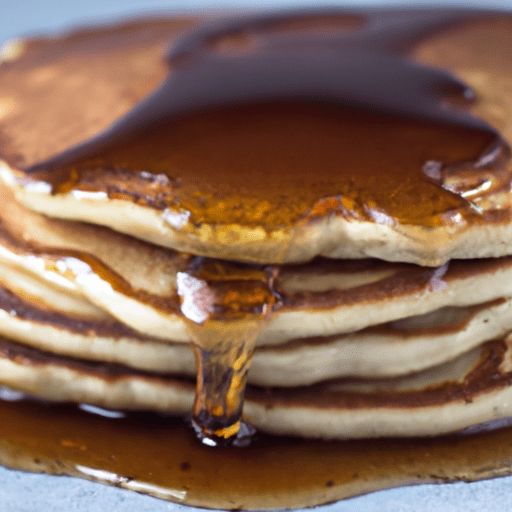The Sweet Side of Breakfast: Exploring Sugar-Free Breakfast Syrup
Welcome to the delicious world of sugar-free breakfast syrup! Whether you’re looking to reduce your sugar intake or simply explore new flavors, this alternative to traditional syrup is a delightful addition to your morning routine. In this post, we will dive into the wonderful world of sugar-free breakfast syrup, exploring its taste, common uses in cooking, nutritional value, and some interesting history and facts that will leave you craving more!
A Taste of Sweet Satisfaction
Sugar-free breakfast syrup offers a delightful sweetness without the guilt of added sugars. Made with sugar substitutes like stevia or sugar alcohols such as erythritol, these syrups pack a punch in terms of flavor, mimicking the taste of natural sweeteners. While the texture might differ slightly from traditional syrup, the taste is pleasantly reminiscent of the sticky, thick goodness we all love.
Versatile Uses in Cooking
Beyond drizzling over pancakes, waffles, or French toast, sugar-free breakfast syrup is a versatile ingredient that can enhance a wide range of dishes. Here are a few creative ways to incorporate this syrup into your culinary adventures:
1. Baked Goods
Adding a touch of sugar-free breakfast syrup to muffins, scones, or even homemade granola bars can infuse a subtle sweetness while keeping the overall sugar content low. It also acts as a natural humectant, helping to retain moisture in your baked treats. So go ahead, get creative with your next batch of goodies!
2. Marinades and Glazes
Looking to add a touch of sweetness to your savory dishes? Sugar-free breakfast syrup works wonders as a base for marinades or glazes for meats and vegetables. Its slightly thick consistency and balanced sweetness lend a delightful caramelized finish to grilled chicken, roasted vegetables, or even tofu stir-fries.
3. Smoothies and Yogurt Parfaits
Elevate your breakfast routine by incorporating sugar-free breakfast syrup into your favorite smoothies or yogurt parfaits. It effortlessly blends with other ingredients, adding a burst of sweetness to your morning bowl of goodness. Try drizzling it over a bowl of Greek yogurt topped with fresh berries and granola – the perfect balance of flavors awaits!
Nutritional Value
One of the key advantages of sugar-free breakfast syrup is its lower calorie and carbohydrate content compared to traditional syrups. As it is made with sugar substitutes, it can be an appealing option for those watching their sugar intake or following a low-carb lifestyle. However, it is essential to be mindful of the sugar alcohols used in these syrups, as they can have a laxative effect if consumed in excess.
When it comes to vitamins and minerals, sugar-free breakfast syrup might not boast an impressive profile. However, some manufacturers fortify their products with additional nutrients, such as Vitamin C or iron. Be sure to read the labels and choose a brand that aligns with your personal nutritional goals.
A Brief History and Fun Facts
Did you know that maple syrup, a popular breakfast staple, was originally discovered by Indigenous peoples in North America? They extracted sap from the maple tree and reduced it to create the sweet golden syrup we adore today. Although sugar-free breakfast syrup deviates from traditional maple syrup production, it pays homage to the longstanding history and love for sweet breakfast condiments.
Another interesting tidbit is that sugar substitutes have been used for centuries. Stevia, a plant native to South America, has been used for its sweetening properties for hundreds of years. The modern-day production of sugar-free products has allowed for the exploration of numerous alternative sweeteners, making it easier for people to enjoy delicious, sugar-free options.
Conclusion
Sugar-free breakfast syrup opens a realm of possibilities for those seeking a guilt-free and flavorful addition to their morning routine. With its delightful taste, versatile uses in cooking, lower calorie content, and fascinating history, it’s no wonder why this alternative syrup has gained popularity. So go ahead, drizzle with creativity, and savor every bite – breakfast just got a whole lot sweeter!
Sugar-Free Breakfast Syrup
Origin: Sugar-free breakfast syrup is a variation of traditional breakfast syrup, specially formulated to be free from added sugars. It is a modern reimagining of the classic pancake and waffle topping.
Common Uses: Sugar-free breakfast syrup is commonly used as a low-calorie alternative to traditional syrup for topping pancakes, waffles, French toast, or other breakfast foods. It can also be used in baking or as a sweetener in various recipes.
Nutritional Benefits: Sugar-free breakfast syrup is typically lower in calories and carbohydrates compared to regular syrup, making it a suitable choice for individuals following a low-sugar or low-carb diet. It may also be used by people with diabetes or those watching their blood sugar levels.
Unique Properties: Sugar-free breakfast syrup is made using sugar substitutes, such as artificial sweeteners like sucralose, stevia, or sugar alcohols like erythritol. These substitutes mimic the sweetness of sugar without contributing to the overall sugar or calorie content.
Historical Significance: The concept of sugar substitutes and sugar-free products emerged due to an increasing interest in health-conscious eating and dietary restrictions. The development and popularity of sugar-free breakfast syrup are part of a larger trend of creating alternatives that cater to various dietary needs and preferences.




Use the share button below if you liked it.
It makes me smile, when I see it.